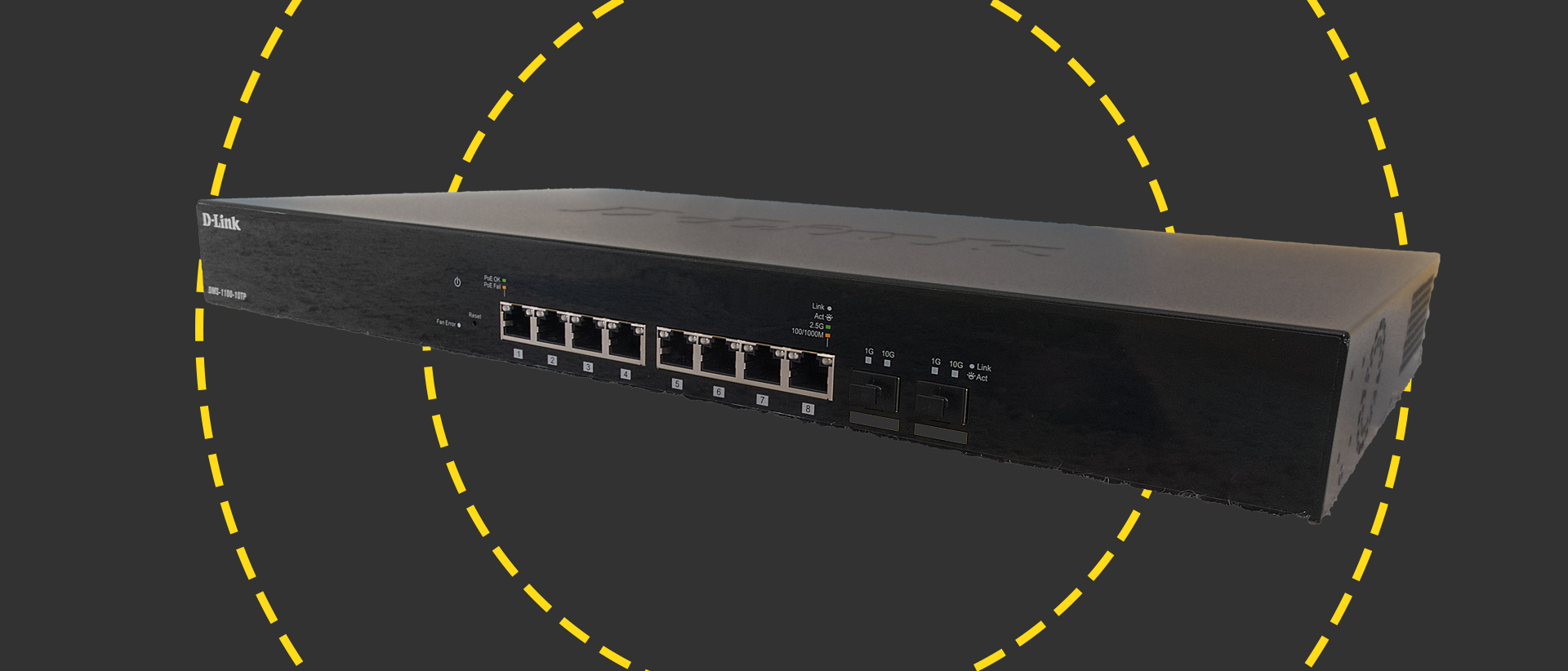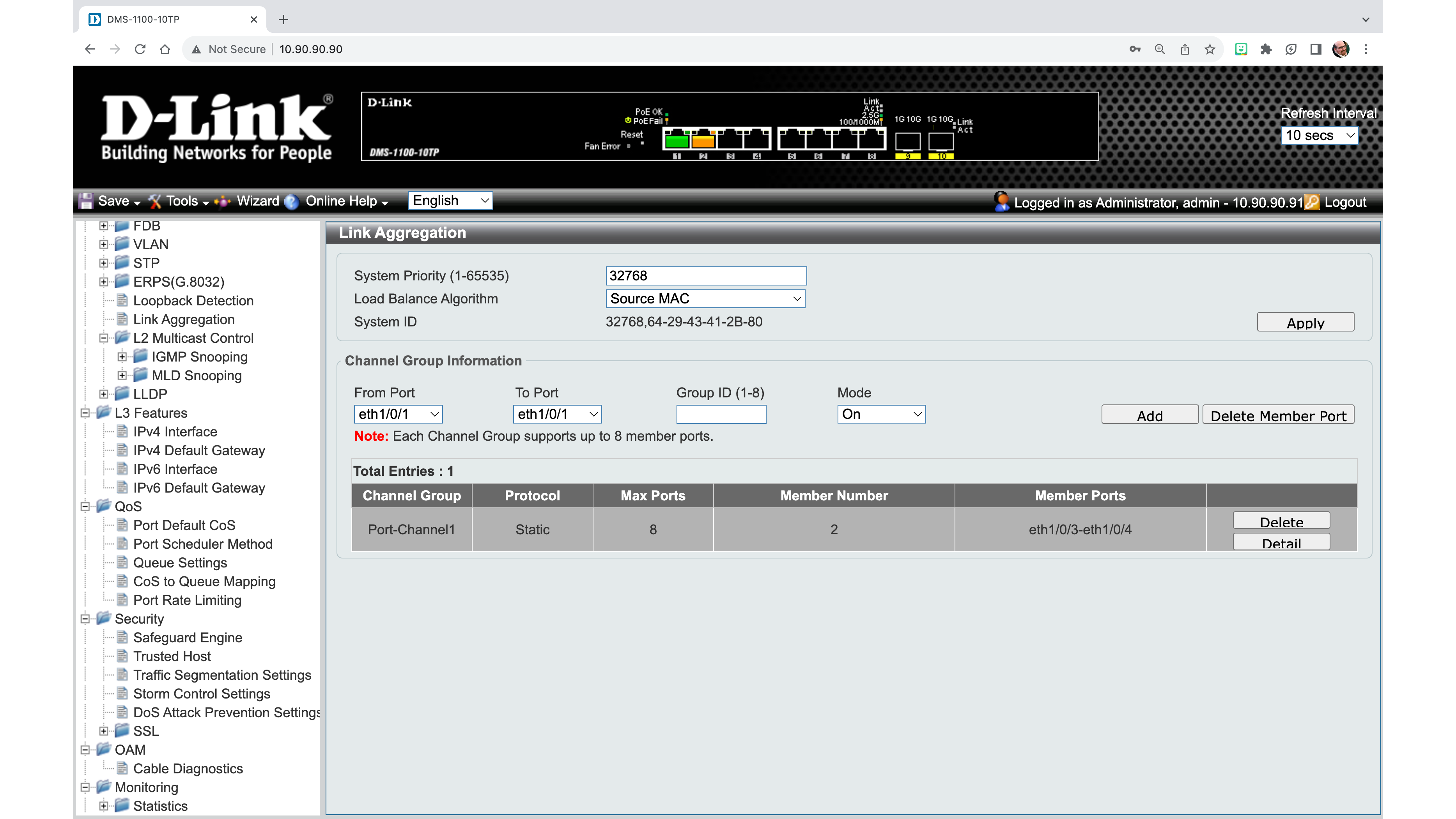D-Link DMS-1100-10TP network switch review: A very affordable way to deliver a speed boost
This 2.5GbE PoE+ switch is ideal for smaller businesses on a budget

-
+
Multi-gigabit on every port
-
+
Full PoE+ support
-
+
Highly versatile management interface
- +
-
-
Number of ports could be limiting

As network demands grow and grow, multi-gigabit connections are becoming a must-have. And with wireless networks and IP security systems becoming the norm, demand is also growing for the convenience of power-over-Ethernet. However, enterprise-grade infrastructure is overkill for small businesses, and the price is hard to justify.
D-Link's DMS-1100-10TP is a tempting compromise. It costs well under £600 and comes armed with eight 2.5GbE ports, plus a pair of 10Gbits/sec SFP uplink connectors to ensure your data keeps flowing smoothly. D-Link claims a maximum packet forwarding rate of 59.5Mbits/sec, meaning that all ten ports can run simultaneously at their full respective speeds if required.
As well as fast network connections, the DMS-1100-10TP supports 802.3at PoE+, allowing it to provide up to 30W of power on all eight downlink ports. The 240W power budget is big enough to supply every port at once, so this switch can happily drive a fleet of Wi-Fi 6 APs and security cameras, with no need for messy external power supplies and extra cables. Note though that it won't power the newest, most demanding PoE++ devices.
Physically the DMS-1100-10TP isn't much to look at. At the front sit the eight copper network ports and two fibre ports, with LEDs indicating the speed and PoE state of each link. The back is almost entirely bare, with nothing to see but a power socket, a grounding connector, and a Kensington lock slot. At only 250mm deep it'll sit comfortably on a desk, or you can screw on the supplied ears to slot it into a standard rack.
Management could hardly be simpler: when you first set up the switch, D-Link's web-based Smart Wizard walks you through configuring your IP and SNMP settings. After this, you arrive at a dashboard showing CPU and RAM usage, along with a graphical representation of the data and power status of each port.

At the left-hand side of the window, a tree of options exposes dozens of pages of settings. It only takes a few clicks to manage the speed of each network port, monitor and configure PoE and adjust all sorts of routing and security options; interestingly, up to eight ports can be aggregated together for extra bandwidth, so you could in theory combine the whole set of 2.5GbE ports into one ultra-fat connection, and use the two SFP+ ports as a single 20Gbits/sec uplink.
QoS and rate-limiting options are on hand too, to ensure that priority traffic takes precedence. The switch can intelligently sort IP camera footage onto its own VLAN, and enable a separate VLAN for VoIP traffic. Loopback detection and cable diagnostics help troubleshoot configuration errors and problems with the physical layer, while port mirroring can be used to monitor traffic and diagnose subtler network issues. For shared administrative duties you can configure multiple users with different privilege levels, and since the whole thing works over a standard HTTP connection, remote access can be easily granted via VPN.
As well as being versatile, the DMS-1100-10TP aims to be green. It proudly supports 802.3ax Energy-Efficient Ethernet, meaning that its ports draw minimal power when not actively transmitting or receiving data. D-Link claims a maximum power consumption of 38.1W, excluding PoE; with two clients connected and exchanging data we measured a modest 30.5W, while the manufacturer cites an even lower draw of 27.3W in standby.
For SMBs seeking to expand their networks, the D-Link DMS-1100-10TP has a lot to recommend, including PoE+, easy management, and troubleshooting capabilities that wouldn't be out of place on far more expensive hardware. The sticking point might be the number of ports: for anything more than a smallish office, eight isn't enough to serve every computer and access point. Still, for £564 exc VAT it's a very affordable way to deliver a speed boost to the devices and clients that need it most – and since 2.5GbE runs over regular Cat5e, you don't even need to replace your cabling.
Get the ITPro daily newsletter
Sign up today and you will receive a free copy of our Future Focus 2025 report - the leading guidance on AI, cybersecurity and other IT challenges as per 700+ senior executives
Darien began his IT career in the 1990s as a systems engineer, later becoming an IT project manager. His formative experiences included upgrading a major multinational from token-ring networking to Ethernet, and migrating a travelling sales force from Windows 3.1 to Windows 95.
He subsequently spent some years acting as a one-man IT department for a small publishing company, before moving into journalism himself. He is now a regular contributor to IT Pro, specialising in networking and security, and serves as associate editor of PC Pro magazine with particular responsibility for business reviews and features.
You can email Darien at darien@pcpro.co.uk, or follow him on Twitter at @dariengs.
-
 Westcon-Comstor and Vectra AI launch brace of new channel initiatives
Westcon-Comstor and Vectra AI launch brace of new channel initiativesNews Westcon-Comstor and Vectra AI have announced the launch of two new channel growth initiatives focused on the managed security service provider (MSSP) space and AWS Marketplace.
By Daniel Todd Published
-
 Third time lucky? Microsoft finally begins roll-out of controversial Recall feature
Third time lucky? Microsoft finally begins roll-out of controversial Recall featureNews The Windows Recall feature has been plagued by setbacks and backlash from security professionals
By Emma Woollacott Published
-
 The UK government wants quantum technology out of the lab and in the hands of enterprises
The UK government wants quantum technology out of the lab and in the hands of enterprisesNews The UK government has unveiled plans to invest £121 million in quantum computing projects in an effort to drive real-world applications and adoption rates.
By Emma Woollacott Published